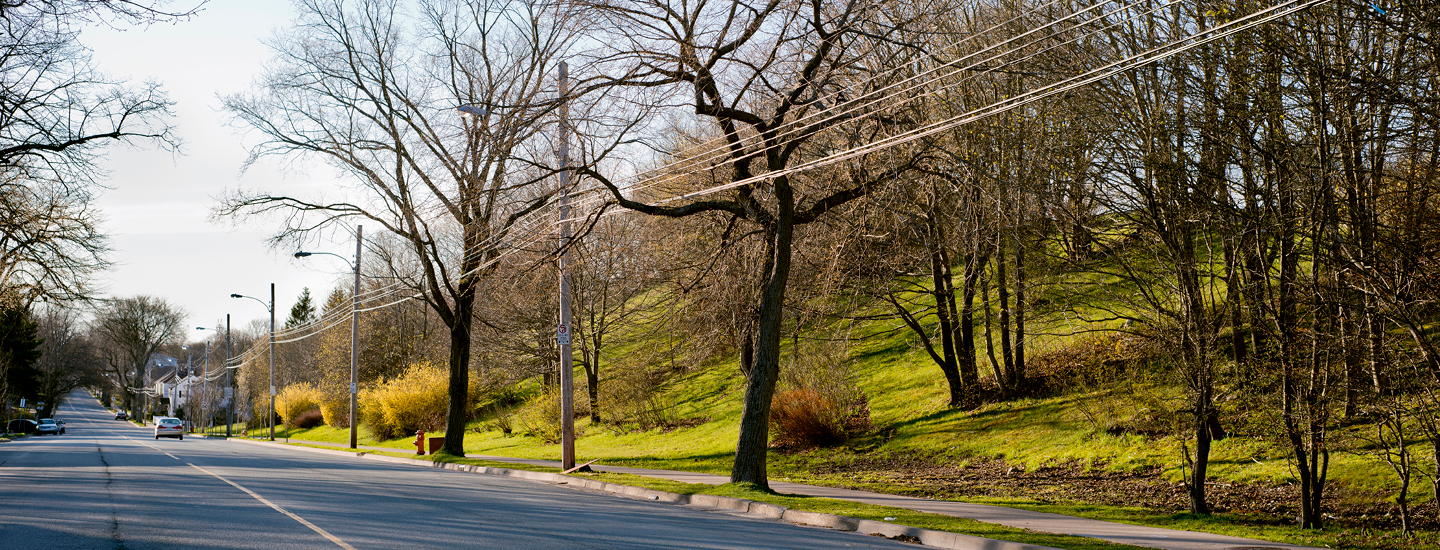Power line safety
Keep your distance from downed power lines and watch for hidden electricity hazards. Electricity is usually silent and invisible. While we use it safely in our lights and appliances, it can be deadly if electricity from a power line finds a path to the ground through you. Here are some tips for living and working safely around power lines.
Report electricity emergencies and hazards
If you see an electricity hazard or a downed power line, stay at least 10 metres (33 feet, about the length of a school bus) away and call our emergency line at 1-866-436-7847 (24 hours) or dial 911 right away.
Downed power lines can be deadly

Even if it doesn’t look like it, a downed wire may still carry power that can jump a distance.
What to do if a wire falls on your vehicle
If a wire falls on your vehicle after an accident, stay calm and call for help.
Stay in your vehicle until help arrives. If you must get out, be careful, as you could become a path for electricity to the ground. Here are some steps to follow:
- Open your door and prepare to jump clear of your vehicle.
- Jump out and land on both feet. You must not touch the vehicle and ground at the same time with any part of your body or clothing.
- After you land, keep both feet on the ground at all times. Keep calm and shuffle along the ground with feet together until you’re at least 10 metres (33 feet) away from the vehicle.
Be aware of overhead power lines
Whenever you’re working outdoors or up on a roof, always look up to see if there are any power lines nearby. Remember that electricity can jump from a power line, so make sure you keep your distance:
- Stay at least six metres* (20 feet) away from transmission lines. These are the large, high-voltage lines on tall towers that carry electricity long distances.
- Stay at least six metres* (20 feet) away from overhead power lines. These are the lines you typically see along streets delivering power to neighbourhoods.
- Stay at least one metre (3 feet) away from service drops. These are the smaller lines that connect power from the main line to your home.
- Stay at least 10 metres (33 feet) away from a downed power line. Always treat it as live and dangerous.
Working near overhead power lines
- Stay alert and keep yourself away from power lines.
- Look for wires hidden in tree branches or vegetation and don’t touch trees that have come into contact with a power line. Anyone touching or standing near the tree could get an electric shock. Call us at 1-866-436-7847 to report hazards.
- Keep your equipment—like tools, ladders, and cranes—at least three metres (10 feet) away from overhead power lines and six metres (20 feet) away from transmission lines at all times.
- Be careful with irrigation pipes around power lines, as both water and metal pipes can conduct electricity. Look up and be aware of overhead power lines when moving them, and store pipes at least 10 metres (33 feet) away from any power lines.
- When moving equipment, have someone watch and warn you if you’re getting too close to overhead power lines.
*Note: transmission power lines (high-voltage) can look very similar to overhead power lines. We recommend you err on the side of caution and stay as far away as possible to ensure your safety.
Trees near power lines

Trees near power lines have to be maintained so they don’t become a hazard or cause power outages. Some examples include:
- Storm risk: trees growing too close to power lines could fall onto the wires in a storm.
- Damage: trees or large branches could fall and tear down entire lines or break the poles holding the line in place.
- Shock hazard: trees that come into contact with wires can become energized, putting anyone nearby at risk.
- Fire or outage: trees or branches in contact with the power line could cause a power outage or start a fire.
Trees and power lines on private property
Property owners are responsible for maintaining trees near power lines serving their premises. In other words, you must ensure the wires from the street to your house remain clear of trees and other plant growth.
Plan ahead when planting trees
Here are some tips to avoid having to cut down or trim your tree later on:
- Plan for the tree’s full size. Visualize the tree at its full height and width when preparing to plant. As it grows, it may become a hazard if it grows into the power line.
- Choose the right spot. Plant large trees well away from the power line. Consider wind movement, the spread of the canopy and the distance they could reach if they fall or blow over.
- Before you dig, click or call BC 1 Call to find out where underground power or gas lines are buried so you can avoid planting trees near them or damaging underground equipment. This service is fast, free and required by law.
Learn more about safe planting before you start.
Hire professionals to prune trees near power lines
Only trained utility arborists should trim trees around power lines. Untrained individuals can get seriously injured—or even killed if they attempt to do this work themselves.
When having your trees trimmed or removed, you can arrange to have your power temporarily disconnected or wires temporarily removed by calling us at 1-866-436-7847. In most cases, there is no charge for this service.